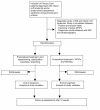Contributions of myofascial pain in diagnosis and treatment of shoulder pain. A randomized control trial
- PMID: 19630975
- PMCID: PMC2724401
- DOI: 10.1186/1471-2474-10-92
Contributions of myofascial pain in diagnosis and treatment of shoulder pain. A randomized control trial
Abstract
Background: Rotator cuff tendinopathy and subacromial impingement syndrome present complex patomechanical situations, frequent difficulties in clinical diagnosis and lack of effectiveness in treatment. Based on clinical experience, we have therefore considered the existence of another pathological entity as the possible origin of pain and dysfunction. The hypothesis of this study is to relate subacromial impingement syndrome (SIS) with myofascial pain syndrome (MPS), since myofascial trigger points (MTrPs) cause pain, functional limitation, lack of coordination and alterations in quality of movement, even prior to a tendinopathy. MTrPs can coexist with any degenerative subacromial condition. If they are not taken into consideration, they could perpetuate and aggravate the problem, hindering diagnosis and making the applied treatments ineffective.The aims and methods of this study are related with providing evidence of the relationship that may exist between this condition and MPS in the diagnosis and treatment of rotator cuff tendonitis and/or SIS.
Method/design: A descriptive transversal study will be made to find the correlation between the diagnosis of SIS and rotator cuff tendonitis, positive provocation test responses, the existence of active MTrPs and the results obtained with ultrasonography (US) and Magnetic Renonance Imaging (MRI). A randomized double blinded clinical trial will be carried out in experimental conditions: A Protocolized treatment based on active and passive joint repositioning, stabilization exercises, stretching of the periarticular shoulder muscles and postural reeducation. B. The previously described protocolized treatment, with the addition of dry needling applied to active MTrPs with the purpose of isolating the efficacy of dry needling in treatment.
Discussion: This study aims to provide a new vision of shoulder pain, from the perspective of MPS. This syndrome can, by itself, account for shoulder pain and dysfunction, although it can coexist with real conditions involving the tendons.
Trial registration: ISRCTN Number: 30907460.
References
-
- Dinnes J, Loveman E, McIntyre L, Waugh N. The effectiveness of diagnostic test for the assessment of shoulder pain due to soft tissue disorders: a systematic review. Heath Technology Assessment. 2003;7:29. - PubMed
-
- Arnalich Jiménez MB, Sánchez Parera R. Guías Clínicas. 2003. http://www.fisterra.com/guias2/hombro.asp
-
- Frost A, Robinson M. The painful shoulder. Surgery. 2006;24:363–367.
Publication types
MeSH terms
Associated data
LinkOut - more resources
Full Text Sources
Medical


